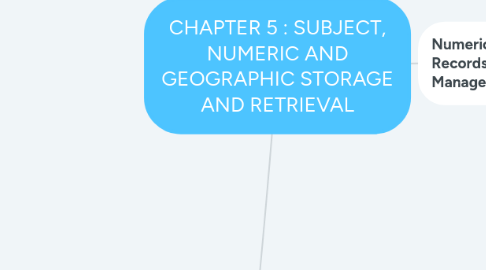
1. Subject Method
1.1. Need For Subject Filing
1.1.1. Types of Arrangement
1.1.1.1. Characteristic
1.1.1.1.1. - primary guide labels contain letter A to Z in alphabetic order
1.1.1.1.2. - special guides identify folders referenced often
1.1.1.1.3. - subject title are not subdivided
1.1.1.2. Encyclopedia Arrangement
1.1.1.2.1. primary - administration
1.1.1.2.2. secondary - building contracts
1.1.1.2.3. tertiary - warehouse
1.1.1.2.4. characteristics
1.1.2. Assigning Subject & The Classification Process
1.1.2.1. classification is the process of
1.1.2.1.1. select the subject heading
1.1.2.1.2. where record should be field
1.1.2.1.3. analyzing and determining the subject content
1.1.2.2. subject indexes
1.1.2.2.1. 1. Master index
1.1.2.2.2. 2. Relative index
1.1.2.2.3. 3. Numeric and names index
1.1.2.2.4. 4. Alphabetic index
1.2. Subject Filing Procedures
1.2.1. Filing records in a subject filing system requires -
1.2.1.1. inspecting
1.2.1.2. indexing
1.2.1.3. coding
1.2.1.4. cross-referencing
1.2.1.5. sorting
1.2.1.6. filing procedures
1.2.1.7. retrieving
1.2.2. Storage and Retrieval Procedures
1.3. Subject Code
1.3.1. to cut short time to write ling subject with subsdivision
1.3.2. it can be one unit or separated by hyphen, period or diagonal
1.3.3. ACC-ACCOUNTING
1.3.4. ADM-ADMINISTRATION
1.4. Advantages subject file
1.4.1. Most records are remembered and retrieved by subject
1.4.2. All records on one topic are retrieved by subject
1.4.3. Subject can expand easily by subdivisions to primary subject
1.4.4. Subject filing is appropriate for storing large volume of records
1.4.5. Security is provided because names are not visible on files
1.5. Disadvantages
1.5.1. subject may overlap when subject list are long with subdivisions
1.5.2. concise, clearly defined and uniformly stated subject titles may be difficult to select
1.5.3. users not may remember exact titles
2. Geographic Records Management
2.1. The need for geographic filing
2.1.1. a method of storing and retrieving records in alphabetical order by location on individual or project
2.1.2. needed to support the requirements of global expanding market activities
2.1.3. example of activities that require decisions based on location
2.1.3.1. scientific research
2.1.3.2. oil and gas exploration
2.1.3.3. facility management
2.1.3.4. real estate transaction
2.1.3.5. emergency response
2.1.3.6. utility and telecommunications services
2.1.3.7. product distribution
2.2. Geographic Filing Method
2.2.1. include geographic filing unit first foll by correspondence name are arrange from major to minor geographic unit
2.2.2. main unit in geographic filing
2.2.2.1. country name
2.2.2.2. stated name
2.2.2.3. city name
2.2.2.4. correspondence name
2.2.3. file arrangement
2.2.3.1. dictionary arrangement
2.2.3.2. encyclopedia arrangement
2.3. Geographic File Indexes
2.3.1. Alphabetic Index
2.3.1.1. contains all correspondents names and their location
2.3.1.2. locates names to find address if not known
2.3.1.3. which in turn will find the location refer to the main geographic file
2.3.1.4. index may be in the form of
2.3.1.4.1. a typed list
2.3.1.4.2. a card file
2.3.1.4.3. a computer generated list
2.3.2. Master Index
2.3.2.1. complete listing of all filing segments in the filing system
2.3.2.2. usage of a database system is an advantage to get both master index and alphabetic index data
2.3.2.3. computer database requires separate field to enable sorting according to location
2.4. Geographic Filing Procedures
2.4.1. 1. inspecting
2.4.2. 2. coding
2.4.3. 3. preparing cross-references
2.4.4. 4. sorting
2.4.5. 5. filing
3. Numeric Records Management
3.1. Need Numeric Filing
3.1.1. - Records must have a unique number
3.1.2. - Number assigned for some meaning
3.1.3. - Numeric filing prevent record to be access by unauthorized
3.2. Consecutive Numbering Method
3.2.1. a. Consecutive Numbering Components
3.2.1.1. An accession log : serial listing of numbers assigned
3.2.1.2. an alphabetic index : used when the correspondent name and subject us known
3.2.1.3. a numbered file: contains number folder
3.2.2. b. Consecutive Numbering Supplies
3.2.2.1. numbered guides and folders
3.2.2.2. alphabetic guides and folders
3.2.2.3. accession log
3.2.2.4. alphabetic index
3.2.3. c. Advantage Of Consecutive Numbering
3.2.3.1. rapid re-filing
3.2.3.2. unlimited expansion
3.2.3.3. easy transfer of inactive records
3.2.3.4. build in security
3.2.4. d. Disadvantages of Consecutive Numbering
3.2.4.1. requires reference to alphabetic index
3.2.4.2. requires more guides
3.2.4.3. more time-consuming
3.2.4.4. congestion
3.3. a) Terminal Digit Storage
3.3.1. Numbers divided into groups
3.3.2. Numbers are read from right to left
3.3.3. End digits are the terminal digits
3.4. b) Middle Digit Storage
3.4.1. Numbers divided into groups
3.4.2. middle groups-middle digits-used as the primary filing division
3.4.3. numbers are read from middle to left to right
3.5. c) Chronological Filing
3.5.1. method of numeric filing system by which records is filed in sequence according to date
3.5.2. records placed in reversed date order within the file folders
3.5.3. oldest records at the back and the most latest in front
